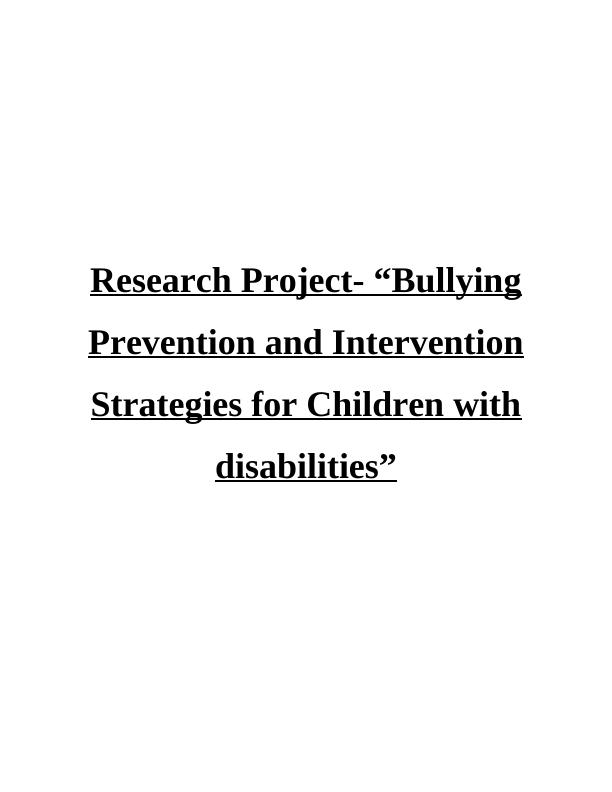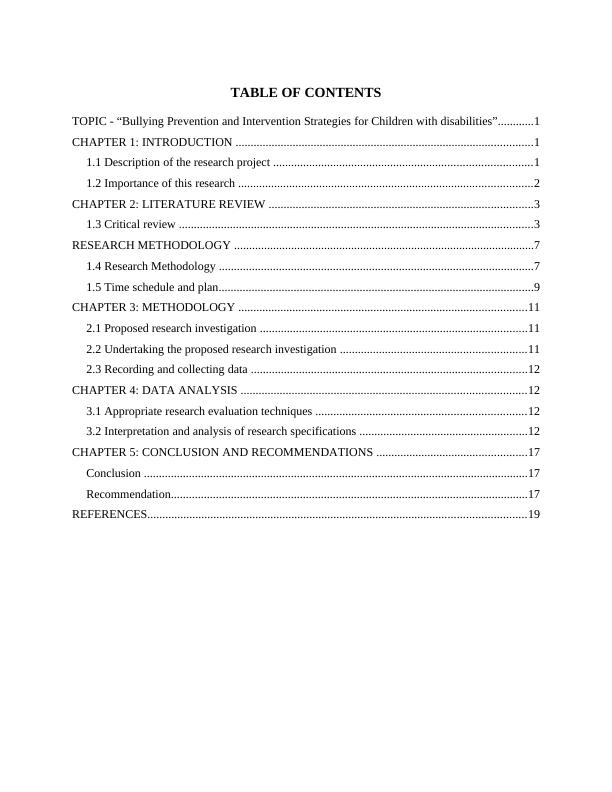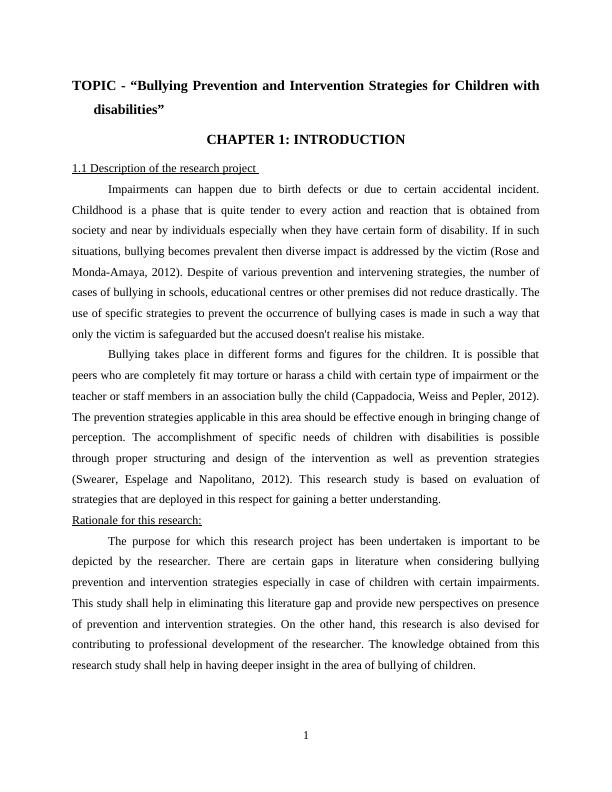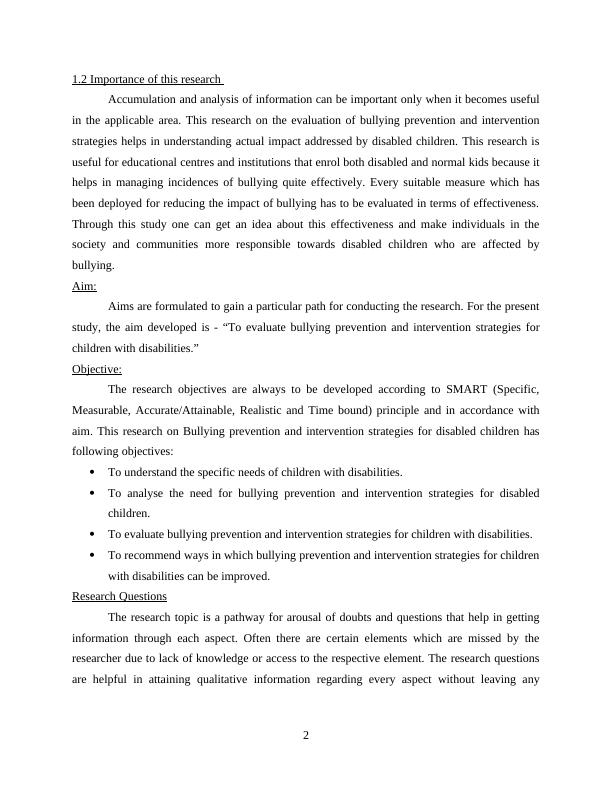Bullying Prevention & Intervention Strategies for Children with Disabilities
Added on 2020-06-03
23 Pages7932 Words51 Views
Research Project- “Bullying
Prevention and Intervention
Strategies for Children with
disabilities”
Prevention and Intervention
Strategies for Children with
disabilities”

TABLE OF CONTENTS
TOPIC - “Bullying Prevention and Intervention Strategies for Children with disabilities”............1
CHAPTER 1: INTRODUCTION ...................................................................................................1
1.1 Description of the research project ......................................................................................1
1.2 Importance of this research ..................................................................................................2
CHAPTER 2: LITERATURE REVIEW ........................................................................................3
1.3 Critical review ......................................................................................................................3
RESEARCH METHODOLOGY ....................................................................................................7
1.4 Research Methodology .........................................................................................................7
1.5 Time schedule and plan.........................................................................................................9
CHAPTER 3: METHODOLOGY ................................................................................................11
2.1 Proposed research investigation .........................................................................................11
2.2 Undertaking the proposed research investigation ..............................................................11
2.3 Recording and collecting data ............................................................................................12
CHAPTER 4: DATA ANALYSIS ...............................................................................................12
3.1 Appropriate research evaluation techniques ......................................................................12
3.2 Interpretation and analysis of research specifications ........................................................12
CHAPTER 5: CONCLUSION AND RECOMMENDATIONS ..................................................17
Conclusion ................................................................................................................................17
Recommendation.......................................................................................................................17
REFERENCES..............................................................................................................................19
TOPIC - “Bullying Prevention and Intervention Strategies for Children with disabilities”............1
CHAPTER 1: INTRODUCTION ...................................................................................................1
1.1 Description of the research project ......................................................................................1
1.2 Importance of this research ..................................................................................................2
CHAPTER 2: LITERATURE REVIEW ........................................................................................3
1.3 Critical review ......................................................................................................................3
RESEARCH METHODOLOGY ....................................................................................................7
1.4 Research Methodology .........................................................................................................7
1.5 Time schedule and plan.........................................................................................................9
CHAPTER 3: METHODOLOGY ................................................................................................11
2.1 Proposed research investigation .........................................................................................11
2.2 Undertaking the proposed research investigation ..............................................................11
2.3 Recording and collecting data ............................................................................................12
CHAPTER 4: DATA ANALYSIS ...............................................................................................12
3.1 Appropriate research evaluation techniques ......................................................................12
3.2 Interpretation and analysis of research specifications ........................................................12
CHAPTER 5: CONCLUSION AND RECOMMENDATIONS ..................................................17
Conclusion ................................................................................................................................17
Recommendation.......................................................................................................................17
REFERENCES..............................................................................................................................19


TOPIC - “Bullying Prevention and Intervention Strategies for Children with
disabilities”
CHAPTER 1: INTRODUCTION
1.1 Description of the research project
Impairments can happen due to birth defects or due to certain accidental incident.
Childhood is a phase that is quite tender to every action and reaction that is obtained from
society and near by individuals especially when they have certain form of disability. If in such
situations, bullying becomes prevalent then diverse impact is addressed by the victim (Rose and
Monda-Amaya, 2012). Despite of various prevention and intervening strategies, the number of
cases of bullying in schools, educational centres or other premises did not reduce drastically. The
use of specific strategies to prevent the occurrence of bullying cases is made in such a way that
only the victim is safeguarded but the accused doesn't realise his mistake.
Bullying takes place in different forms and figures for the children. It is possible that
peers who are completely fit may torture or harass a child with certain type of impairment or the
teacher or staff members in an association bully the child (Cappadocia, Weiss and Pepler, 2012).
The prevention strategies applicable in this area should be effective enough in bringing change of
perception. The accomplishment of specific needs of children with disabilities is possible
through proper structuring and design of the intervention as well as prevention strategies
(Swearer, Espelage and Napolitano, 2012). This research study is based on evaluation of
strategies that are deployed in this respect for gaining a better understanding.
Rationale for this research:
The purpose for which this research project has been undertaken is important to be
depicted by the researcher. There are certain gaps in literature when considering bullying
prevention and intervention strategies especially in case of children with certain impairments.
This study shall help in eliminating this literature gap and provide new perspectives on presence
of prevention and intervention strategies. On the other hand, this research is also devised for
contributing to professional development of the researcher. The knowledge obtained from this
research study shall help in having deeper insight in the area of bullying of children.
1
disabilities”
CHAPTER 1: INTRODUCTION
1.1 Description of the research project
Impairments can happen due to birth defects or due to certain accidental incident.
Childhood is a phase that is quite tender to every action and reaction that is obtained from
society and near by individuals especially when they have certain form of disability. If in such
situations, bullying becomes prevalent then diverse impact is addressed by the victim (Rose and
Monda-Amaya, 2012). Despite of various prevention and intervening strategies, the number of
cases of bullying in schools, educational centres or other premises did not reduce drastically. The
use of specific strategies to prevent the occurrence of bullying cases is made in such a way that
only the victim is safeguarded but the accused doesn't realise his mistake.
Bullying takes place in different forms and figures for the children. It is possible that
peers who are completely fit may torture or harass a child with certain type of impairment or the
teacher or staff members in an association bully the child (Cappadocia, Weiss and Pepler, 2012).
The prevention strategies applicable in this area should be effective enough in bringing change of
perception. The accomplishment of specific needs of children with disabilities is possible
through proper structuring and design of the intervention as well as prevention strategies
(Swearer, Espelage and Napolitano, 2012). This research study is based on evaluation of
strategies that are deployed in this respect for gaining a better understanding.
Rationale for this research:
The purpose for which this research project has been undertaken is important to be
depicted by the researcher. There are certain gaps in literature when considering bullying
prevention and intervention strategies especially in case of children with certain impairments.
This study shall help in eliminating this literature gap and provide new perspectives on presence
of prevention and intervention strategies. On the other hand, this research is also devised for
contributing to professional development of the researcher. The knowledge obtained from this
research study shall help in having deeper insight in the area of bullying of children.
1

1.2 Importance of this research
Accumulation and analysis of information can be important only when it becomes useful
in the applicable area. This research on the evaluation of bullying prevention and intervention
strategies helps in understanding actual impact addressed by disabled children. This research is
useful for educational centres and institutions that enrol both disabled and normal kids because it
helps in managing incidences of bullying quite effectively. Every suitable measure which has
been deployed for reducing the impact of bullying has to be evaluated in terms of effectiveness.
Through this study one can get an idea about this effectiveness and make individuals in the
society and communities more responsible towards disabled children who are affected by
bullying.
Aim:
Aims are formulated to gain a particular path for conducting the research. For the present
study, the aim developed is - “To evaluate bullying prevention and intervention strategies for
children with disabilities.”
Objective:
The research objectives are always to be developed according to SMART (Specific,
Measurable, Accurate/Attainable, Realistic and Time bound) principle and in accordance with
aim. This research on Bullying prevention and intervention strategies for disabled children has
following objectives:
To understand the specific needs of children with disabilities.
To analyse the need for bullying prevention and intervention strategies for disabled
children.
To evaluate bullying prevention and intervention strategies for children with disabilities.
To recommend ways in which bullying prevention and intervention strategies for children
with disabilities can be improved.
Research Questions
The research topic is a pathway for arousal of doubts and questions that help in getting
information through each aspect. Often there are certain elements which are missed by the
researcher due to lack of knowledge or access to the respective element. The research questions
are helpful in attaining qualitative information regarding every aspect without leaving any
2
Accumulation and analysis of information can be important only when it becomes useful
in the applicable area. This research on the evaluation of bullying prevention and intervention
strategies helps in understanding actual impact addressed by disabled children. This research is
useful for educational centres and institutions that enrol both disabled and normal kids because it
helps in managing incidences of bullying quite effectively. Every suitable measure which has
been deployed for reducing the impact of bullying has to be evaluated in terms of effectiveness.
Through this study one can get an idea about this effectiveness and make individuals in the
society and communities more responsible towards disabled children who are affected by
bullying.
Aim:
Aims are formulated to gain a particular path for conducting the research. For the present
study, the aim developed is - “To evaluate bullying prevention and intervention strategies for
children with disabilities.”
Objective:
The research objectives are always to be developed according to SMART (Specific,
Measurable, Accurate/Attainable, Realistic and Time bound) principle and in accordance with
aim. This research on Bullying prevention and intervention strategies for disabled children has
following objectives:
To understand the specific needs of children with disabilities.
To analyse the need for bullying prevention and intervention strategies for disabled
children.
To evaluate bullying prevention and intervention strategies for children with disabilities.
To recommend ways in which bullying prevention and intervention strategies for children
with disabilities can be improved.
Research Questions
The research topic is a pathway for arousal of doubts and questions that help in getting
information through each aspect. Often there are certain elements which are missed by the
researcher due to lack of knowledge or access to the respective element. The research questions
are helpful in attaining qualitative information regarding every aspect without leaving any
2

possibility of not achieving the aim and objectives. Below mentioned are some of the research
questions whose answers shall lead to accomplishment of main motive of the study.
What is bullying?
What kinds of needs are specifically addressed by children with disability?
What are the major prevention strategies applicable in reducing bullying cases with
disabled children?
What is the effect of bullying on disabled children?
What is the impact of different strategies as prevention and intervention of bullying on
disabled children?
In what ways can the on-going strategies be improved?
CHAPTER 2: LITERATURE REVIEW
1.3 Critical review
Bullying
An act of aggression and repetitive behaviour which makes an individual live in fear and
distress is known as bullying (Johnson and Schools, 2012). There is a hairline difference between
bullying and abuse. The person who bullies another person is intending to cause harm, create
fear and develop an environment which is full of negativity so that depiction of greater power
can be achieved. This kind of behaviour is typically repetitive and takes several forms like
physical, verbal and social. When cases of bullying are reported, it is important for the respective
authority to analyse the psychological factors that enforce an individual to take such steps and
bully innocent people. Swearer, Espelage and Napolitano (2012) accounted for the existence of
maintained schools which have proper facilitation for special students.
Physical bullying involves several activities which are violent in one form. These include
kicking, beating, spitting, shoving and even damaging properties. The children with specific
needs are highly vulnerable to physical bullying because of their impairment. Smith (2014)
stated that victims' race, religion and ethnic background is one of the primary factors that
influence people belonging to so-called higher backgrounds or communities to bully the disabled
(Pepler and Craig, 2014). This kind of bullying is categorised as social bullying. It also involves
social exclusion and developing an atmosphere which is not so supportive in their development
(American Educational Research Association, 2013). For instance, a person makes racist jokes
3
questions whose answers shall lead to accomplishment of main motive of the study.
What is bullying?
What kinds of needs are specifically addressed by children with disability?
What are the major prevention strategies applicable in reducing bullying cases with
disabled children?
What is the effect of bullying on disabled children?
What is the impact of different strategies as prevention and intervention of bullying on
disabled children?
In what ways can the on-going strategies be improved?
CHAPTER 2: LITERATURE REVIEW
1.3 Critical review
Bullying
An act of aggression and repetitive behaviour which makes an individual live in fear and
distress is known as bullying (Johnson and Schools, 2012). There is a hairline difference between
bullying and abuse. The person who bullies another person is intending to cause harm, create
fear and develop an environment which is full of negativity so that depiction of greater power
can be achieved. This kind of behaviour is typically repetitive and takes several forms like
physical, verbal and social. When cases of bullying are reported, it is important for the respective
authority to analyse the psychological factors that enforce an individual to take such steps and
bully innocent people. Swearer, Espelage and Napolitano (2012) accounted for the existence of
maintained schools which have proper facilitation for special students.
Physical bullying involves several activities which are violent in one form. These include
kicking, beating, spitting, shoving and even damaging properties. The children with specific
needs are highly vulnerable to physical bullying because of their impairment. Smith (2014)
stated that victims' race, religion and ethnic background is one of the primary factors that
influence people belonging to so-called higher backgrounds or communities to bully the disabled
(Pepler and Craig, 2014). This kind of bullying is categorised as social bullying. It also involves
social exclusion and developing an atmosphere which is not so supportive in their development
(American Educational Research Association, 2013). For instance, a person makes racist jokes
3

End of preview
Want to access all the pages? Upload your documents or become a member.
Related Documents
Bullying prevention and intervention strategies for children with disabilities: Assessing its prevalence and identifying risk and practice factorslg...
|24
|7661
|301
Bullying Prevention and Intervention Strategies for Children with Disabilitieslg...
|4
|1100
|485
Research Methods in Social Science Assessment Module Code: FND3003 Module Description: Research Methods in Social Science Assessmentlg...
|17
|3491
|434
Physical abuse on children with special needslg...
|2
|1738
|41
Statistical mechanics of data collection and analysislg...
|20
|7513
|207
Human Behavior Assignment: Bullyinglg...
|18
|7368
|144
